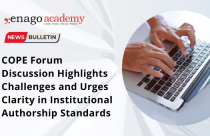Decoding Authorship in Academic Publishing: Guidelines, grey areas, and best practices

Excitement brewed at Dr. Joshi’s biomedical lab as the lab team—Omar (Postdoc), Riya (PhD student), and Jane (Research Assistant) gathered in the tiny meeting room to submit their manuscript. But before finalizing the submission, a pressing question surfaced: “Who will be the first author?”
In academic publishing, authorship is more than just a name on a paper. It signifies responsibility, accountability, and intellectual ownership to the written work. Whether you’re an early-career researcher submitting your first paper or a senior academic managing a multi-institutional team, understanding how authorship is determined and assigned is critical.
What is Authorship?
Authorship in academic publishing refers to the recognition of individuals who have substantially contributed intellectually to the development and publication of a research work. Missteps in authorship such as gift authorship (adding someone who didn’t contribute), ghost authorship (omitting a contributor), or honorary authorship (listing someone based on seniority or influence) can lead to serious consequences like paper retractions, loss of credibility, and institutional investigations and sanctions.
Authorship guidelines are structured criteria that help define who qualifies as an author and the responsibilities they carry. According to the International Committee of Medical Journal Editors (ICMJE) and Nature, an individual qualifies as an author if they:
- Made significant contribution to the ideation/design, or data acquisition/analysis/interpretation
- Involved in the creation of new software used in the work and/or Drafted or reviewed the intellectual areas of the manuscript critically
- Approved the final version to be published and any modified versions involving their contribution
- Demonstrated accountability for the integrity of the work
- Addressed concerns related to the accuracy and integrity of any part of the work
Understanding Authorship Order: First author vs. corresponding author vs co-authors
The order in which authors are listed generally conveys important information about who did what in a research project. In many disciplines, especially in the sciences, the sequence of authors signals the weight and nature of each person’s contribution (known as the “Relative Contribution Method”), and can have direct implications for career advancement, recognition, and credibility.
| Author Position | Typical Meaning | Significance |
| First Author |
|
Highly coveted, especially among early-career researchers, because it’s often seen as evidence of leadership and initiative in the study.
|
| Middle Author(s) |
|
While less spotlighted, they contribute essential support and technical expertise, enriching the study with critical analyses and methodologies |
| Last Author |
|
Reflects strategic guidance, funding leadership, and mentorship rather than hands-on execution. |
| Corresponding Author |
|
Point of contact for future questions, citations, or collaborations. |
As we understand the criteria for authorship, it is crucial to understand that the norms vary across disciplines.
Different Methods for Listing Authors—Subjectwise
1. Pure Mathematics
In pure mathematics, authorship is often alphabetical.
2. Life Sciences
In this field, authorship is assigned based on the “Relative Contribution.”
3. Interdisciplinary Studies
Multiple “first” authors are denoted by an asterisk and is later defined in a note. Furtherm
Omar, who led the experimental design, nodded confidently. Riya had done much of the lab work and data analysis. Jane helped with literature review and formatting—but didn’t engage with the intellectual framing. Did she count as an author?
Because so much professional credit is tied to authorship order, disagreements over placement can arise, especially when roles are not clearly discussed early on. Misunderstanding these norms can lead to conflict, unethical practices, or even institutional investigation. As a result, understanding them and the current authorship guidelines becomes necessary.
Important Guidelines and Points to Consider When Assigning Authorship
1. AI and Authorship
AI tools, including large language models like ChatGPT, cannot be credited as authors. According to the current ethical guidelines, only humans can meet authorship criteria, as AI tools do not demonstrate accountability and critical thinking. However, usage of AI tools must be transparently disclosed in the “Methods” or “Acknowledgments” sections.
2. Author Contribution Statements
These statements are now mandatory in many journals (e.g., Elsevier, Springer) to clarify who did what. The CRediT taxonomy (Contributor Roles Taxonomy) is the emerging standard, defining 14 specific roles (e.g., methodology, software, supervision).
3. Name Changes and Anonymous Authorship
Institutions should support name change requests due to gender transition, marriage/divorce, or personal preference. Journals like PLOS and Wiley allow for silent corrections, ensuring privacy. Anonymous or pseudonymous authorship is typically discouraged unless necessary for protection (e.g., in politically sensitive research) which the journals assess these on a case-by-case basis.
4. Consortia Authorship
For large-scale projects often involve dozens (or hundreds) of contributors. Journals may list the consortium as the author (e.g., The ENCODE Project Consortium) and include named individuals in appendices or supplementary files. Furthermore, they may require detailed contributions from each participant.
5. Primary Affiliation
The primary affiliation for each author should be the institution where the majority of their work was done. If an author has subsequently moved, the current address may also be stated. Springer Nature remains neutral with regard to jurisdictional claims in published maps and institutional affiliations. For group authorship during collaboration, journals like Nature and Science have detailed policies, requiring clear identification of responsible individuals and contribution statements.
6. Post-Submission Contact and Communication
The corresponding author is the point of contact for any queries about the manuscript. They are required to inform any matter regarding the paper to all co-authors, irrespective of their order in the authorship and address them promptly. Additionally, changes to the author list and order post submission must be communicated before manuscript acceptance, post approval of every author.
7. Acknowledgement Vs. Authorship
Acknowledgment—rather than authorship—is appropriate for individuals who provided technical support, those who helped with language editing or proofreading, Supervisors or heads of departments without direct contribution, and those who provided general funding or infrastructure. These contributors can be recognized in the Acknowledgments section, but listing them as authors is unethical unless they meet the ICMJE criteria.
As the team discussed these guidelines, they understood that Jane’s contribution, though valuable, didn’t qualify for authorship. “She should be acknowledged, not added as an author,” Omar confirmed, to set ethical clarity. Here’s how the authorship order might look for the fictional Dr. Joshi’s lab, based on their contributions.
Example of an Authorship Order and Contribution Statement
Authors: Riya Jacob, Dr. Omar Rehman, Dr. Steve Joshi
Authorship Contribution Statement (using CRediT taxonomy)
Riya Jacob: Led the investigation, analyzed data, and drafted the manuscript.
Omar Rehman: Designed the methodology, coordinated the research team, and revised the manuscript critically
Dr. Steve Joshi: Supervised the study, secured funding, and oversaw manuscript review and integrity.
Acknowledgments
“We thank Jane Yang for her assistance with literature collation and formatting support. We’d also like to thank Enago Top Impact Scientific Editing Service for their help in editing this paper.”
To ensure the team does not face challenges associated with authorship in the future, they decided to document a few must-follow practices.
 Using trusted services like Enago’s Publication Support Service can help ensure your manuscript meets international standards for authorship, formatting, and ethics. These services also help reduce the chance of accidental authorship violations by reviewing contribution statements and disclosures.
Using trusted services like Enago’s Publication Support Service can help ensure your manuscript meets international standards for authorship, formatting, and ethics. These services also help reduce the chance of accidental authorship violations by reviewing contribution statements and disclosures.
As you’ve likely realized, determining the correct authorship order isn’t always straightforward. Institutions and labs can consider collaborating with professional editing services like Enago as their experienced editors can flag inconsistencies in author information, verify that contribution statements align with journal requirements, and ensure compliance with ethical standards. These services not only enhance the clarity and quality of your manuscript, but also act as a critical checkpoint for authorship accuracy and transparency.
As academic research becomes more complex, collaborative, and cross-disciplinary, authorship decisions require thoughtful planning and transparent communication. Because in the end, authorship isn’t just about credit—it’s about trust, integrity, and accountability.









